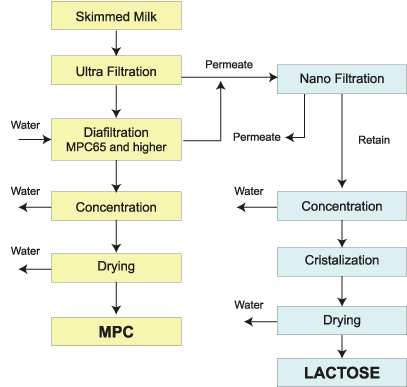Milk and Whey High Protein Concentrates
SEI CONTRERAS Engineering has long searched for new technologies, especially those involving concentration and fractioning separation.
In that spirit we have begun working on membrane filtration technologies, with focus on the dairy industry. The most important advances have occurred in the processes related to that industry, with new products being launched based on process technology development possibilities.
These separation unit operations, based on fractioning, are classified according to the average size of the macro-molecules retained:
REVERSE OSMOSIS: ideally, it can be considered that every component is retained by the membranes with the exception of the solvent.
NANOFILTRATION: it uses membranes with a slighter bigger mesh that reverse osmosis, but small enough to retain simple sugar molecules.
ULTRAFILTRATION: only macro-molecules are retained, with an average size of 10200 Aº (approximately 0.001 to 0.02 μm)
MICROFILTRATION: it retains particles between 0.1 and 10 μm
DIAFILTRATION: it's a membrane system used in the ultrafiltration process that allows water into the equipment when protein recovery is elevated.
Separation and concentration of milk and whey proteins remaining after cheese production have generated new products with a high market value:
MPC: Milk Protein Concentrates
MPI: Milk Protein Isolates
WPC: Whey Protein Concentrates
WPI: Whey Protein Isolates
Other products derived from from casein like Β-CN (Beta Casein, one of the most important fractions of casein), phosphopeptides, glycomacropeptides, α-lacto albumen, Β-lacto globulins and immunoglobulins.
MILK PROTEIN CONCENTRATES
Basic process diagram for obtaining of this high value-added product that takes skim milk as a feedstock and separates protein components from lactose and salts:

Protein concentration in the final dry product range between 42 to 80 %, and lactose content diminishes as protein percentage increases.
| Component | Skimmed Milk % | MPC 42 % | MPC 56 % | MPC 70 % | MPC 80 % |
|---|---|---|---|---|---|
| Humidity | 3.2 | 3.5 | 3.8 | 4.2 | 3.9 |
| Fat | 0.8 | 1 | 1.2 | 1.4 | 1.8 |
| Proteins | 36 | 42 | 56 | 70 | 82.8 |
| Lactose | 52 | 46 | 31 | 16.2 | 4.1 |
| Ashes | 8 | 7,5 | 8 | 8.2 | 7.4 |
Proteins found in these products keep their nutritional qualities intact, given that they have not suffered almost any degree of denaturation, which allows their usage in high nutritional foods or their manufacturing processes. This applies to:
Calcium enriched milk: The MPC solves the problema of adding soluble calcium to milk, avoiding its precipitation because it does not alter the ionic calcium balance. In this product, calcium is bonded to the casein molecule, whose micelles are retained by ultrafiltration. Product with up to 10 times the regular amount of calcium were obtained, which are highly recommendable for osteoporosis prevention and treatment.
Cheese manufacturing: Given the importance of standarizing the casein content in order to achieve better yields and a constant quality in the final product, especially for continuous manufacturing processes, the addition of MPC with its non-degraded proteins and without lactose has made this possible.
Special milks: The possibility to modifiy the protein/lactose ratio has allowed the development of a long list of "custom-made" dairy products. These excellent dairy products can contribute to the daily diet with an average of 360 kcal / 100 grams.
Protein fractioning: The MPC, even before its evaporation and drying, is used as raw material for the fractioning of its components (casein, globulin, ferritin, and others) for functional foods and pharmaceutical applications.
Ice cream production: To improve ice cream texture besides lowering lactose content to avoid its crystalization and sand-like consistency in the product
This way, the development of new products derived from MPC and the technology of membrane filtration, daily enrich the product portfolio derived from them and available for the market.
